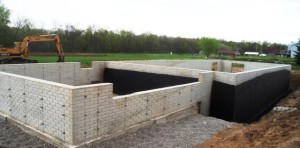Modular Home Basement: Concrete Block vs. Poured Concrete
One use of a poured concrete wall is in the foundation of a home. Concrete is used because it won’t rot when exposed to the moisture in the ground, it’s fairly economical and easy to use and it’s strong enough to support the weight of your house. In modular home basement construction, concrete block or poured concrete is used.
Concrete blocks and poured concrete can be compared and contrasted in a number of ways. Although poured concrete is stronger than concrete blocks, it is a bit more expensive, and although blocks are cheaper to install than poured concrete, they are more likely to seep and retain water, thus allowing penetration of moisture to an interior wall.
Quality of Modular Home Basement Materials
Concrete blocks must be laid one single block at a time, whereas poured concrete is installed in one monolithic structure, which naturally makes the unit stronger; however, concrete blocks can be laid with type S mortar and have every fourth block cell filled solid with concrete and rebar, but, generally, block construction is best for projects that will not exert very much horizontal pressure on the construction of the blocks. Poured concrete serves best when it is installed as a barrier or retaining wall. This type of construction will hold off tons of pressure.
Cost of Modular Home Basement Materials
In 2002, the cost of installing blocks per square foot was roughly $3, including labor and materials. During the same year, the cost of installing poured concrete was around $6 per square foot, including material and labor. As of 2010, even though the labor cost has remained the same, the material costs have risen by $1. However, these costs change when you remove the labor cost from the two and decide to do it yourself. The concrete block price drops by $1 per square foot, and the poured concrete price drops by $3. These prices may also vary from location to location.
Disadvantages of Concrete Block and Poured Concrete
Most problems in each application occur because of poor installation. A poured concrete installation will crack and settle if the footers are poorly installed, such as if they are too thin or are not wide enough to support the weight of the poured concrete.
Concrete blocks are prone to water penetration because of the porous nature of the block materials. The block joints may also break down over time, thus allowing the structure to crumble and deteriorate.
Poured concrete problems can be solved by making sure that plenty of rebar is installed in the wet concrete to prevent separation of the materials once they dry. Make sure that the footing for the poured concrete is at least 12 inches thick and 16 inches wide.
You can prevent concrete block problems by using type S mortar for the installation and by painting a water barrier paint onto the surface of the blocks.
In case you still have question about modular homes, you may contact Legendary Homes Inc in Jackson, Michigan. A representative will be happy to assist you. Meanwhile you can check our modular home price sheets by signing up to our blog
Topic: Modular Home Basement and Poured Concrete



